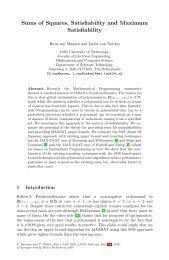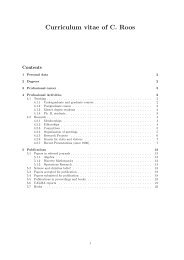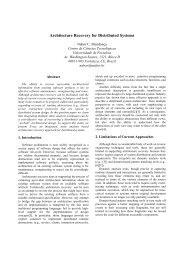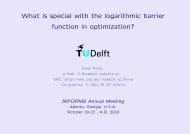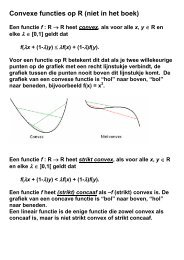Full-Newton step polynomial-time methods for LO based on locally ...
Full-Newton step polynomial-time methods for LO based on locally ...
Full-Newton step polynomial-time methods for LO based on locally ...
You also want an ePaper? Increase the reach of your titles
YUMPU automatically turns print PDFs into web optimized ePapers that Google loves.
Proof of Theorem 3We apply the compositi<strong>on</strong> rule, which is well known.Lemma 3 Let φ i be (κ i , ν i )-SCB’s <strong>on</strong> D i , <str<strong>on</strong>g>for</str<strong>on</strong>g> i = 1,2. Then φ 1 + φ 2 is a (κ, ν)-SCB<str<strong>on</strong>g>for</str<strong>on</strong>g> D 1 × D 2 , where κ = max {κ 1 , κ 2 } and ν = ν 1 + ν 2 .Since the linear part in φ µ (x, s) is 0-self-c<strong>on</strong>cordant, with ν = 0, it suffices to c<strong>on</strong>siderf(x, s) = 2n∑j=1ψ b(√xj s jµwhere s = s(x) = Mx + q. In the sequel we will neglect this relati<strong>on</strong> between s and x.Thus we will prove that f(x, s) is (κ, ν)-self-c<strong>on</strong>cordant <strong>on</strong> the set{(x, s) : x ∈ Rn+ , s ∈ R n }+ .),This will imply that f(x, s) is a (κ, ν)-self-c<strong>on</strong>cordant barrier functi<strong>on</strong> <str<strong>on</strong>g>for</str<strong>on</strong>g> the domain of(SP), which is the intersecti<strong>on</strong> of this set and affine space determined by s = Mx + q.We do this by c<strong>on</strong>sidering each of the terms in the definiti<strong>on</strong> separately and then apply thecompositi<strong>on</strong> rules of Lemma 3.23




